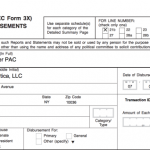Philanthropy In 2017 Saw The Rise Of Trump-Powered Giving
The Trump administration’s efforts to deregulate industry, enforce Muslim bans, oppose abortion, and deny climate change have inspired a new charitable term. It’s dubbed “rage philanthropy”–when you’re giving is aimed at protecting whatever basic rights and values the president trivializes.
Here’s one example: When Trump announced his Muslim travel ban in late January, rage philanthropists countered by donating $24 million to the ACLU in a single weekend, a sum that grew to $79 million during the first three months after the inauguration, according to Newsweek. There are plenty of others. After Trump’s first 100 days in office, nonprofit evaluator Charity Navigator reported a huge increase in donations to progressive groups including the ACLU (up 8,000%), Southern Poverty Law Center (up 1,400%) and Planned Parenthood (up 1,000%) along with the American Refugee Committee and Environmental Defense Fund.

Blue Giving Vs. Red Giving
Behavior like that is expected to contribute to record-breaking charitable totals in 2017, although what happens next is a bit murky, thanks to a different Trump effect: His new tax plan, which takes effect in 2018, will substantially shift how people are donating because of a change in what they can deduct.
Americans have been philanthropically generous for years now. In 2016, charities received $390 billion from U.S. donors, a historic increase for the third year in a row. More than 70% of those funds came from individual donors, with foundations and corporations making up the difference. Experts think that trend will likely continue in 2017, but who is doing the giving may be politically tinged: Democrats are expected to donate about 50% more than usual this year, while Republicans will give 28% more, mostly in ways that follow party lines. The left is backing women’s rights, the environment, and civil liberties. The right is all about religious groups and military and veteran associations.
But Bethany Maki, vice president of nonprofit strategy at PMX Agency, a marketing group associated with that study, says that the concept of rage giving has evolved too. “People are sort of past the chapter of rage and now it is more about a proactive [financial] activism for the causes that they care about,” she says. Liberals especially see donating toward contested topics as voting with their dollars.
Conservatives don’t claim to think like that; they’re just donating to their usual spots, but now more heavily, because the strong economy makes them feel more financially secure. (In fact, religious Republicans typically don’t reduce their donations in economically down times because they tend to see such contributions more like “tithing,” Maki says.)
Much of the uptick in activism based contributions is coming from young Democrats, whose spending power is still relatively low. That’s not the case for Republican contributors, who are mostly older, well established, an on pace to average about $2,000 per person this year (or 55% more than their blue counterparts).

The Rise Of Donor Advised Funds
Donor-Advised Funds (DAFs) are a type of savings and investment vehicle that allows donors to set aside money for charity and gain the tax benefits of doing so immediately, even though there’s no immediate timetable to distributing that sum. In general, the idea is to let money in these havens accrue more value, while figuring out how it can be best spent. (DAF’s are also popular for allowing holders to pour in non-cash assets like public stock, private company shares, and real estate gains without paying capital gains tax.)
Last year, many of America’s 285,000 DAF users decided to give heavily–allocating about 20% of their holdings on average or $15.1 billion overall–to different causes, according to a trend report by the National Philanthropic Trust, an industry group with major accounts. NPT President and CEO Eileen Heisman attributes that, in part, to donors battling against the political machine, something that’s continued throughout 2017. “We have seen some spikes that I think are reactionary to policies. For example, there was a spike in grants to environmental causes this summer after President Trump announced the U.S. plans to withdraw from the Paris Agreement,” she says in an email to Fast Company.
Distributions from Schwab Charitable’s DAF holders, where the minimum account balance is $5,000, illuminate a bit more. This year, the company had a major shakeup among the five most popular groups being funded. Planned Parenthood jumped from fifth to second place, just behind the consistent number one group, Feeding America. The ACLU also made the shortlist for the first time in recent memory, displacing Campus Crusade for Christ from the roll of top earners. (The other two groups featured were Doctors Without Borders and the Salvation Army.) Kim Laughton, president of Schwab Charitable, told Fast Company previously that these groups received a combined $25 million, which is 66% more than the top nonprofits in 2016. Others like SPLC and the Natural Resources Defense Council saw “big increases.”
For Schwab, at least, that growth appears to be continuing. At the end of November, contributions to Schwab DAFs were up 15% year-over-year, with grants up 22%, although there are plenty of non-Trump related causes that people are probably giving toward, like hurricane and wildfire disaster relief.

How The Tax Bill Will Change Giving In 2018
All of this is in advance of a potential massive game-changer. In 2018, Trump’s current tax bill, which has gained initial approval in both the House and Senate, will likely reduce the incentive for Americans to give. That’s because the tax plan doubles the standardized deduction to around $24,000, which means fewer Americans may consider it necessary to make charitable deductions to offset their wages.
That creates a practical if coldly calculated conundrum. “We never say that tax policy is why people give,” says Jason Lee, who chairs of the Charitable Giving Coalition, a collection of over 200 groups including the Association of Fundraising Professionals, Council on Foundations, and United Way Worldwide, which opposed the plan. “People give because they’re generous, they’re philanthropic, but tax policy does encourage them to give more often and give larger gifts.”
To that end, the Tax Policy Center projects that Trump’s tax plan will generate a loss of between $12 and $20 billion in expected donations annually, based on the House bill that passed in November. Another issue, the repeal of estate tax, will take an additional $4 billion out of the sector starting in 2025. Traditionally, the federal government levies and additional tax of up to 40% on inheritances above $5.5 million. Each charitable dollar given away lowers what’s taxable by that same amount, which can dramatically reduce the overall percentage owed. As more Tax Policy Center research shows, that’s how Henry Ford’s sons grew the Ford Foundation. Take away that transfer-of-wealth penalty, and posthumous donations from rich benefactors could drop between 15% and 30% each year.
An analysis from the Lilly Family School of Philanthropy at Indiana University suggests that 28 million “average American” families might stop itemizing. That could mean fewer donations flowing to the places where those folks traditionally give, like neighborhood-level group and causes, at a time when those gifts are increasingly needed. But average Americans have been giving less overall to these groups for a while now. Rich donors control a much larger portion of what’s given each year, and they tend to favor large organizations.
Yet nonprofits that rely on major donor money will likely see less of that because of another new tax wrinkle. Currently, people who itemize can deduct up to 50% of their gross pay when giving to charities, with part of that put against the money they might owe the IRS. That part isn’t changing. However, the percentage of what may be offset will, particularly among the richest, because several tax brackets are being consolidated in a way that lowers that rate. (Vox estimates it’ll be about $11,000 less per $1 million donated.)
It’s tough to speculate exactly how the damage will play out. “Everybody has concerns,” adds Lee at the Charitable Giving Coalition.”I don’t know if we know the full impact. That’s what is the scariest part about all this.”
Despite President Trump’s wishes, legislators ultimately threw out another reform that would have upended how the sector does business completely. When the tax bill passed the House in early November, it included a provision to repeal the Johnson Amendment, a tax code rule that restricts nonprofits and churches from endorsing or opposing political candidates. The mandate was eventually dropped the final tax bill, but it may show back up in future legislation.
If it ever did pass, groups could align directly with political candidates, not just coyly related issues. For some donors, that might be a turn-off. For others, it could be a chance to treat nonprofits like a new kind of political action committee, without the current $5,000 restriction on individual donations. Either way, political donations get taxed while charitable ones don’t. And charities can legally remain private about who is backing them to avoid donors being persecuted for their beliefs. Combine those two things, and you get a dark money loophole estimated to cost the federal treasury about $2.1 billion in shifted allocations over the next 10 years, according to the Joint Committee on Taxation. “This is not the kind of charitable giving increase that we want to see,” says Mike Geiger, the president and CEO of the Association of Fundraising Professionals in an email to Fast Company.
That strange reality isn’t here—yet. In the meantime, the most basic question of how influential activism-related philanthropy may become probably hinges the president’s next move. In December, the administration’s plan to reduce the size and protections of national monuments led to another massive wave of funding for conservationist groups. If Trump’s actions become more outlandish, such generosity may escalate. “We are living in a bit of an unprecedented time in how the news cycle affects giving,” says Maki at PMX. “So we shall see.”
Fast Company , Read Full Story
(19)














